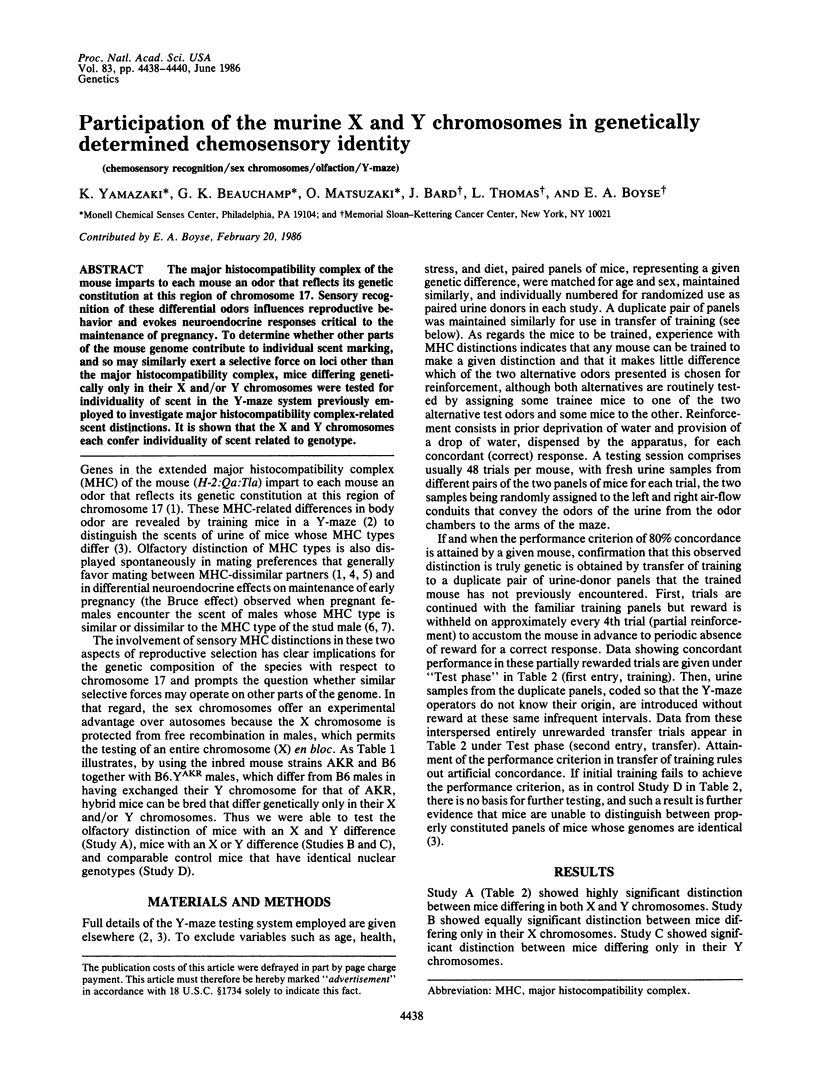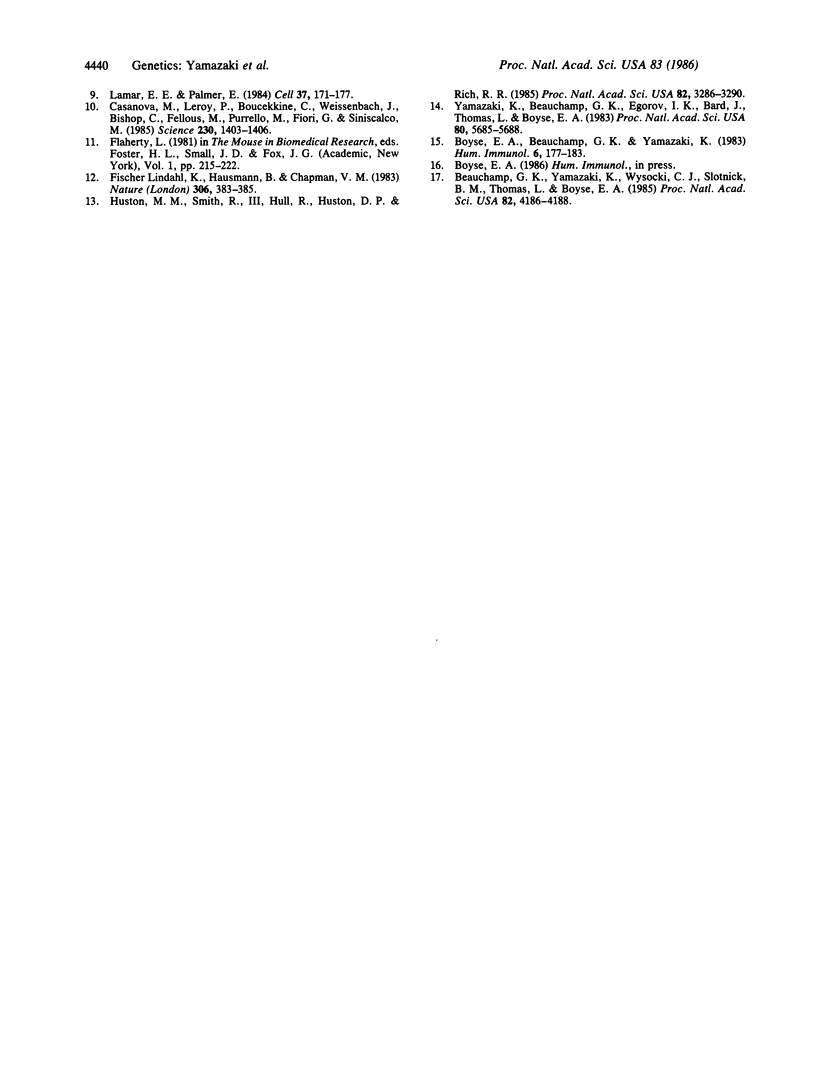Abstract
The major histocompatibility complex of the mouse imparts to each mouse an odor that reflects its genetic constitution at this region of chromosome 17. Sensory recognition of these differential odors influences reproductive behavior and evokes neuroendocrine responses critical to the maintenance of pregnancy. To determine whether other parts of the mouse genome contribute to individual scent marking, and so may similarly exert a selective force on loci other than the major histocompatibility complex, mice differing genetically only in their X and/or Y chromosomes were tested for individuality of scent in the Y-maze system previously employed to investigate major histocompatibility complex-related scent distinctions. It is shown that the X and Y chromosomes each confer individually of scent related to genotype.
Full text
PDF


Selected References
These references are in PubMed. This may not be the complete list of references from this article.
- Beauchamp G. K., Yamazaki K., Wysocki C. J., Slotnick B. M., Thomas L., Boyse E. A. Chemosensory recognition of mouse major histocompatibility types by another species. Proc Natl Acad Sci U S A. 1985 Jun;82(12):4186–4188. doi: 10.1073/pnas.82.12.4186. [DOI] [PMC free article] [PubMed] [Google Scholar]
- Boyse E. A., Beauchamp G. K., Yamazaki K. Critical review: the sensory perception of genotypic polymorphism of the major histocompatibility complex and other genes: some physiological and phylogenetic implications. Hum Immunol. 1983 Apr;6(4):177–183. doi: 10.1016/0198-8859(83)90090-3. [DOI] [PubMed] [Google Scholar]
- Casanova M., Leroy P., Boucekkine C., Weissenbach J., Bishop C., Fellous M., Purrello M., Fiori G., Siniscalco M. A human Y-linked DNA polymorphism and its potential for estimating genetic and evolutionary distance. Science. 1985 Dec 20;230(4732):1403–1406. doi: 10.1126/science.2999986. [DOI] [PubMed] [Google Scholar]
- Huston M. M., Smith R., 3rd, Hull R., Huston D. P., Rich R. R. Mitochondrial modulation of maternally transmitted antigen: analysis of cell hybrids. Proc Natl Acad Sci U S A. 1985 May;82(10):3286–3290. doi: 10.1073/pnas.82.10.3286. [DOI] [PMC free article] [PubMed] [Google Scholar]
- Lamar E. E., Palmer E. Y-encoded, species-specific DNA in mice: evidence that the Y chromosome exists in two polymorphic forms in inbred strains. Cell. 1984 May;37(1):171–177. doi: 10.1016/0092-8674(84)90312-x. [DOI] [PubMed] [Google Scholar]
- Lindahl K. F., Hausmann B., Chapman V. M. A new H-2-linked class I gene whose expression depends on a maternally inherited factor. Nature. 1983 Nov 24;306(5941):383–385. doi: 10.1038/306383a0. [DOI] [PubMed] [Google Scholar]
- Yamaguchi M., Yamazaki K., Beauchamp G. K., Bard J., Thomas L., Boyse E. A. Distinctive urinary odors governed by the major histocompatibility locus of the mouse. Proc Natl Acad Sci U S A. 1981 Sep;78(9):5817–5820. doi: 10.1073/pnas.78.9.5817. [DOI] [PMC free article] [PubMed] [Google Scholar]
- Yamazaki K., Beauchamp G. K., Bard J., Thomas L., Boyse E. A. Chemosensory recognition of phenotypes determined by the Tla and H-2K regions of chromosome 17 of the mouse. Proc Natl Acad Sci U S A. 1982 Dec;79(24):7828–7831. doi: 10.1073/pnas.79.24.7828. [DOI] [PMC free article] [PubMed] [Google Scholar]
- Yamazaki K., Beauchamp G. K., Egorov I. K., Bard J., Thomas L., Boyse E. A. Sensory distinction between H-2b and H-2bm1 mutant mice. Proc Natl Acad Sci U S A. 1983 Sep;80(18):5685–5688. doi: 10.1073/pnas.80.18.5685. [DOI] [PMC free article] [PubMed] [Google Scholar]
- Yamazaki K., Beauchamp G. K., Matsuzaki O., Kupniewski D., Bard J., Thomas L., Boyse E. A. Influence of a genetic difference confined to mutation of H-2K on the incidence of pregnancy block in mice. Proc Natl Acad Sci U S A. 1986 Feb;83(3):740–741. doi: 10.1073/pnas.83.3.740. [DOI] [PMC free article] [PubMed] [Google Scholar]
- Yamazaki K., Beauchamp G. K., Wysocki C. J., Bard J., Thomas L., Boyse E. A. Recognition of H-2 types in relation to the blocking of pregnancy in mice. Science. 1983 Jul 8;221(4606):186–188. doi: 10.1126/science.6857281. [DOI] [PubMed] [Google Scholar]
- Yamazaki K., Boyse E. A., Miké V., Thaler H. T., Mathieson B. J., Abbott J., Boyse J., Zayas Z. A., Thomas L. Control of mating preferences in mice by genes in the major histocompatibility complex. J Exp Med. 1976 Nov 2;144(5):1324–1335. doi: 10.1084/jem.144.5.1324. [DOI] [PMC free article] [PubMed] [Google Scholar]
- Yamazaki K., Yamaguchi M., Baranoski L., Bard J., Boyse E. A., Thomas L. Recognition among mice. Evidence from the use of a Y-maze differentially scented by congenic mice of different major histocompatibility types. J Exp Med. 1979 Oct 1;150(4):755–760. doi: 10.1084/jem.150.4.755. [DOI] [PMC free article] [PubMed] [Google Scholar]


